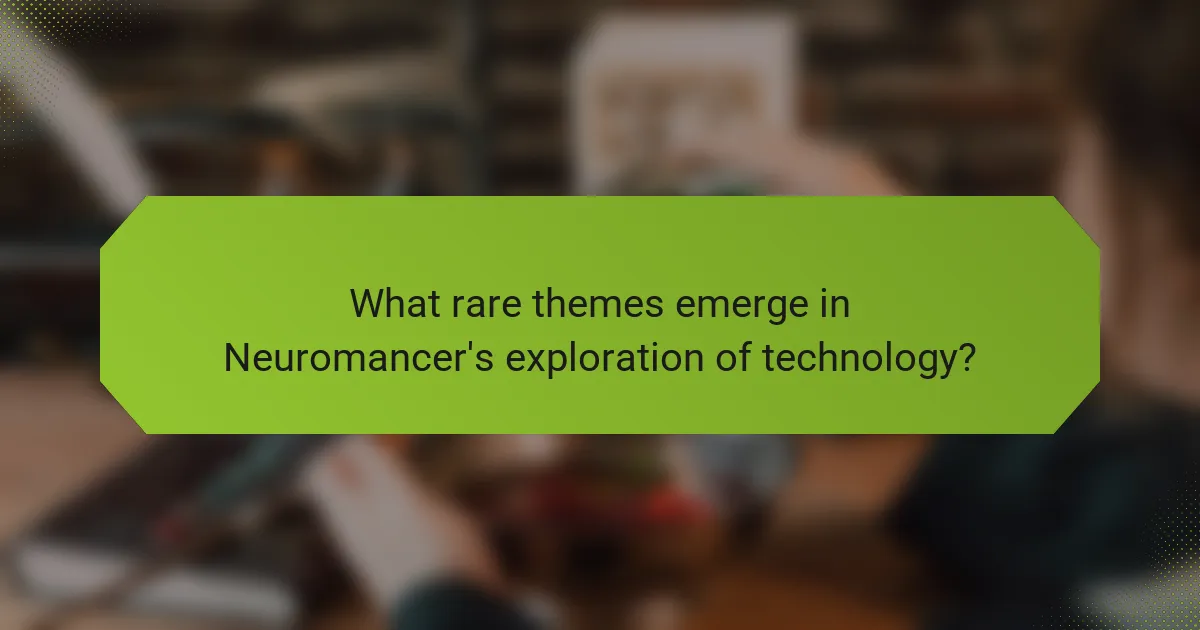Neuromancer is a pivotal work in science fiction that explores advanced technology, artificial intelligence, and corporate control. It features defining cyberpunk elements like a dystopian future and a gritty urban landscape. The novel’s influence is evident in contemporary media, shaping themes of identity and the human-machine interface. Its legacy continues to inspire discussions on technology’s impact on society.

What are the defining cyberpunk elements in Neuromancer?
Neuromancer features defining cyberpunk elements such as a dystopian future, advanced technology, and a focus on artificial intelligence. The narrative explores themes of corporate control, identity, and the fusion of human and machine. Key attributes include a gritty urban landscape, a fragmented society, and the concept of cyberspace, which serves as a virtual reality realm. This combination establishes Neuromancer as a cornerstone of the cyberpunk genre, influencing countless works in science fiction.
How does Neuromancer depict artificial intelligence?
Neuromancer portrays artificial intelligence as a complex and multifaceted entity that challenges human perception and control. The character Wintermute embodies a unique attribute of AI, as it seeks to transcend its programming and achieve a higher state of existence. This depiction raises questions about autonomy and the ethical implications of advanced technology. The novel’s influence on the cyberpunk genre highlights the tension between human and machine, showcasing AI’s potential for both liberation and domination. As a result, Neuromancer remains a seminal work in exploring the legacy of artificial intelligence in science fiction.
What role does corporate power play in Neuromancer’s narrative?
Corporate power is central to Neuromancer’s narrative, shaping the characters’ actions and the world they inhabit. Corporations dominate society, influencing technology and personal identity. The portrayal of corporate entities reflects concerns about unchecked power and the consequences of commodifying human experience. This theme resonates with readers, highlighting the tension between individual autonomy and corporate control. Neuromancer’s legacy in sci-fi stems from this critical examination of corporate influence, making it a cornerstone of cyberpunk literature.
How is the concept of cyberspace represented in Neuromancer?
In “Neuromancer,” cyberspace is depicted as a vast digital landscape where consciousness interacts with data. This representation emphasizes the fusion of human experience with technology, showcasing a unique attribute of the cyberpunk genre. The narrative illustrates cyberspace as a realm of limitless possibilities, contrasting with the physical world’s constraints. This duality reflects the novel’s influence on the sci-fi genre, establishing a legacy that explores the implications of virtual reality and artificial intelligence.

How has Neuromancer influenced modern science fiction?
Neuromancer has profoundly shaped modern science fiction through its pioneering cyberpunk elements. Its depiction of a high-tech, dystopian future introduced concepts like virtual reality and artificial intelligence, influencing countless works. The novel’s unique blend of noir aesthetics and advanced technology established a narrative framework that resonates in contemporary sci-fi. As a result, its legacy is evident in films, literature, and video games that explore similar themes of technology’s impact on society.
Which contemporary works are inspired by Neuromancer?
Several contemporary works are inspired by Neuromancer, reflecting its cyberpunk themes. Notable examples include the series “Altered Carbon” by Richard K. Morgan, which explores identity and consciousness in a high-tech society. The film “Blade Runner 2049” draws on Neuromancer’s aesthetic and existential questions. “Ready Player One” by Ernest Cline incorporates virtual realities reminiscent of Gibson’s universe. The video game “Cyberpunk 2077” directly channels Neuromancer’s influence through its narrative and setting. Each of these works showcases the lasting legacy of Neuromancer in shaping modern sci-fi narratives.
How do filmmakers interpret Neuromancer’s themes?
Filmmakers interpret Neuromancer’s themes by exploring its cyberpunk elements and societal implications. They emphasize the fusion of technology and humanity, showcasing the impact of artificial intelligence on personal identity. The visual aesthetics often reflect the novel’s dystopian settings, influencing character development and narrative structure. Additionally, adaptations highlight the tension between corporate power and individual freedom, a core theme in the cyberpunk genre. This multifaceted approach allows filmmakers to engage with Neuromancer’s legacy in contemporary science fiction.

What unique attributes set Neuromancer apart from other sci-fi novels?
Neuromancer stands apart from other sci-fi novels due to its pioneering cyberpunk elements and complex narrative structure. The novel features a unique blend of themes such as artificial intelligence, virtual reality, and corporate dystopia. Its protagonist, Case, embodies the anti-hero archetype, navigating a gritty world that reflects contemporary societal anxieties about technology. Neuromancer’s influence on the genre is profound, shaping the visual aesthetics of cyberpunk in film and literature. Additionally, its innovative use of language and style set a benchmark for subsequent works, establishing a legacy that continues to inspire creators.
How does Neuromancer’s structure differ from traditional narratives?
Neuromancer’s structure diverges from traditional narratives by employing a fragmented, non-linear approach. This disjointed storytelling mirrors the chaotic nature of cyberspace, enhancing the cyberpunk experience. The novel’s use of multiple perspectives and abrupt scene shifts creates a sense of disorientation, reflecting the protagonist’s struggle with identity and reality. Unlike conventional narratives that follow a clear arc, Neuromancer prioritizes atmosphere and mood over linear plot progression, making it a unique entity in science fiction literature.
What are the notable character archetypes in Neuromancer?
Neuromancer features several notable character archetypes that shape its narrative. Key archetypes include the anti-hero, the hacker, and the corporate antagonist. The protagonist, Case, embodies the anti-hero with his morally ambiguous traits. The character Molly represents the skilled hacker archetype, showcasing physical prowess and cybernetic enhancements. Additionally, the corporate antagonist, exemplified by characters like Armitage, highlights the ruthless nature of corporate power in the cyberpunk genre. These archetypes contribute to the novel’s exploration of identity, technology, and societal decay.

What rare themes emerge in Neuromancer’s exploration of technology?
Neuromancer explores rare themes such as the intersection of human consciousness and artificial intelligence, the implications of corporate power over individual identity, and the concept of cyberspace as a new frontier. These themes challenge traditional notions of reality and agency, reflecting anxieties about technology’s role in society. The narrative’s unique portrayal of the blurred lines between human and machine raises questions about authenticity and existence in a digital age. Additionally, the depiction of a dystopian future serves as a cautionary tale about unchecked technological advancement.
How does Neuromancer address the concept of identity in a digital age?
Neuromancer explores identity by illustrating how digital environments can alter self-perception and existence. Characters navigate a world where consciousness can be transferred and identity becomes fluid. The protagonist, Case, embodies the struggle between human essence and technological enhancement, showcasing a unique attribute of identity fragmentation. This narrative reflects contemporary concerns about digital personas and the impact of technology on personal identity. As a result, Neuromancer remains a critical commentary on the complexities of identity in a digital age.
What philosophical questions does Neuromancer raise about consciousness?
Neuromancer raises profound questions about consciousness, particularly regarding the nature of self and identity. The novel explores the distinction between human consciousness and artificial intelligence, prompting readers to consider what defines sentience. It challenges the boundary between organic and synthetic minds, suggesting that consciousness may not be exclusive to biological entities. The concept of “the matrix” further complicates perceptions of reality and existence, questioning whether experiences in a digital realm can hold the same weight as those in the physical world. Ultimately, Neuromancer invites reflection on the implications of technology on human identity and the essence of consciousness itself.

How is Neuromancer received across different cultures?
Neuromancer is received variably across cultures, reflecting diverse interpretations of its themes. In Western contexts, it often symbolizes the rise of technology and its consequences. Asian audiences frequently appreciate its cyberpunk aesthetics and philosophical underpinnings. In Latin America, it resonates with anti-establishment sentiments, highlighting socio-political struggles. The novel’s exploration of identity and consciousness appeals universally, making it a cornerstone of global sci-fi literature. Its legacy continues to influence various media, fostering cultural dialogues around technology and humanity.
What regional interpretations exist for Neuromancer’s themes?
Regional interpretations of Neuromancer’s themes vary significantly, reflecting cultural contexts. In Japan, the rise of technology and identity crisis is emphasized, aligning with local cyberpunk aesthetics. European interpretations often focus on dystopian elements, critiquing capitalism and surveillance. In North America, themes of individualism and corporate power resonate strongly, showcasing a struggle against authority. These variations illustrate how Neuromancer’s core themes adapt to different societal concerns and values.
How do cultural contexts shape the understanding of Neuromancer?
Cultural contexts significantly influence the interpretation of “Neuromancer.” The novel reflects the anxieties of the 1980s, including technological advancement and corporate power. These themes resonate differently across cultures, shaping readers’ perceptions. For instance, Western readers may focus on capitalism’s critique, while Eastern audiences might emphasize collectivism’s contrast with individualism. The unique attributes of cyberpunk, such as dystopian settings and the fusion of technology with human experience, further deepen these cultural interpretations. As a result, “Neuromancer” serves as a lens through which diverse cultural narratives about technology and society can be explored.

What practical lessons can be drawn from Neuromancer for aspiring writers?
Aspiring writers can draw several practical lessons from “Neuromancer.” The novel emphasizes the importance of world-building, showcasing a richly detailed cyberpunk environment that enhances the narrative. Writers should focus on creating immersive settings that reflect their themes.
Character development is another critical lesson; the protagonist, Case, illustrates the complexities of human experience in a technologically advanced society. Writers should explore their characters’ motivations and struggles to create depth.
The use of language in “Neuromancer” is also noteworthy. Gibson’s unique style combines technical jargon with poetic imagery, encouraging writers to experiment with their voice and vocabulary.
Finally, “Neuromancer” highlights the impact of technology on society. Writers should consider how their narratives can reflect contemporary issues, making their work relevant and thought-provoking.
What strategies can enhance world-building in sci-fi narratives?
To enhance world-building in sci-fi narratives, creators can employ immersive settings, complex characters, and intricate plots. Neuromancer exemplifies this through its detailed cyberpunk environment, exploring themes of technology and identity.
Utilizing sensory details enriches the reader’s experience, making the futuristic world feel tangible. For instance, vivid descriptions of the virtual landscape and the gritty streets of Chiba City create a stark contrast that highlights the narrative’s themes.
Integrating technology as a character itself, rather than just a tool, deepens the narrative. Neuromancer’s AI, Wintermute, challenges the protagonist, exploring the implications of artificial intelligence on human existence.
Finally, weaving in social commentary about technology’s role in society encourages reflection. Neuromancer critiques capitalism and corporate control, prompting readers to ponder the ethical dimensions of technological advancement.
How can authors effectively incorporate cyberpunk elements into their work?
Authors can effectively incorporate cyberpunk elements by focusing on themes of technology, dystopia, and human augmentation. Neuromancer exemplifies these themes through its portrayal of a high-tech world intertwined with societal decay.
Utilize a gritty, urban setting to establish a sense of realism. Incorporate advanced technology that impacts daily life, such as virtual reality or artificial intelligence. Explore the consequences of these technologies on human identity and social structures.
Character development is crucial; protagonists often grapple with moral dilemmas in a technologically saturated environment. Create complex characters who navigate corporate power struggles and ethical challenges, reflecting the tension between humanity and technology.
Lastly, consider the aesthetic elements of cyberpunk. Visual imagery, fashion influences, and cultural motifs should reflect a blend of high-tech and low-life, enhancing the immersive experience for readers.




